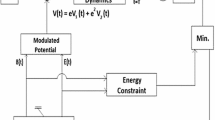Abstract
This paper deals with the design of quantum unitary gate by matching the Hermitian generators. A given complicated quantum controlled gate is approximated by perturbing a simple quantum system with a small time-varying potential. The basic idea is to evaluate the generator \(H_\varphi \) of the perturbed system approximately using first-order perturbation theory in the interaction picture. \(H_\varphi \) depends on a modulating signal \(\varphi (t){:}\; 0\le t\le T\) which modulates a known potential V. The generator \(H_\varphi \) of the given gate \(U_\mathrm{g}\) is evaluated using \(H_\mathrm{g}=\iota \log U_g\). The optimal modulating signal \(\varphi (t)\) is chosen so that \(\Vert H_g - H_\varphi \Vert \) is a minimum. The simple quantum system chosen for our simulation is harmonic oscillator with charge perturbed by an electric field that is a constant in space but time varying and is controlled externally. This is used to approximate the controlled unitary gate obtained by perturbing the oscillator with an anharmonic term proportional to \(q^3\). Simulations results show significantly small noise-to-signal ratio. Finally, we discuss how the proposed method is particularly suitable for designing some commonly used unitary gates. Another example was chosen to illustrate this method of gate design is the ion-trap model.



Similar content being viewed by others
References
Cleve, R., Ekert, A., Macchiavello, C., Mosca, M.: Quantum algorithms revisited. Proc. R. Soc. Lond. A 454, 339 (1998)
Nielsen, M.A., Chuang, I.L.: Quantum Computation and Quantum Information. Cambridge University Press, Cambridge (2001)
DiVincenzo, D.P.: Two-bit gates are universal for quantum computation. Phys. Rev. A 51, 1015 (1995)
Galindo, A., Martin-Delgado, M.A.: Information and computation: classical and quantum aspects. Rev. Mod. Phys. 74, 347 (2002)
Slepoy, A.: Quantum gate decomposition algorithms, Sandia Report, SAND2006-3440, Printed July (2006)
Blaauboer, M., de Visser, R.L.: An analytical decomposition protocol for optimal implementation of two-qubit entangling gates. J. Phys. A 41, 395307 (2008)
Altafini, C.: On the generation of sequential unitary gates from continuous time Schrödinger equations driven by external fields. Quant. Inform. Process. 1, 207–224 (2002)
Barenco, A., Bennett, C.H., Cleve, R., DiVincenzo, D.P., Margolus, N., Shor, P., Sleator, T., Smolin, J.A., Weinfurter, H.: Elementary gates for quantum computation. Phys. Rev. A. 52, 3457–3467 (1996)
Zhang, Y., Kauffman, L.H., Ge, M.-L.: Yang–Baxterizations, universal quantum gates and Hamiltonians. Quant. Inform. Process. 4, 159–197 (2005)
Hirota, O.: Some remarks on a conditional unitary operator. Phys. Lett. A 155(6–7), 343–347 (1991)
Lloyd, S.: Almost Any quantum logic gate is universal. Phys. Rev. Lett. 75, 346 (1995)
Wang, T.J., Wang, C.: Universal hybrid three-qubit quantum gates assisted by a nitrogen-vacancy center coupled with a whispering-gallery-mode microresonator. Phy. Rev. A 90, 052310 (2014)
Levi, D., Moshinsky, M.: Relations between hyperspherical and harmonic-oscillator many-body matrix elements. Il Nuovo Cimento A 20(1), 107–114 (1974)
Feranchuk, I.D., Komarov, L.I., Nichipor, I.V., Ulyanenkov, A.P.: Operator method in the problem of quantum anharmonic oscillator. Ann. Phys. 238(2), 370–440 (1995)
Dirac, P.A.M.: The Principles of Quantum Mechanics, 4th edn. Oxford University Press, New York (1958)
Perelomov, A.M.: Generalized Coherent States and Their Applications, Texts and Monographs in Physics. Springer, Berlin (1986)
Glauber, R.J.: Coherent and incoherent states of radiation field. Phys. Rev. 131, 2766–2788 (1963)
Klauder, J.R., Skagerstam, B.: Coherent States. World Scientific, Singapore (1985)
Gazeau, J.P.: Coherent States in Quantum Physics. Wiley, Berlin (2009)
Combescure, M., Robert, D.: Coherent States and Applications. Mathematical Physics. Springer, New York (2012)
Gautam, K., Chauhan, G., Rawat, T.K., Parthasarathy, H., Sharma, N.: Realization of quantum gates based on three-dimensional harmonic oscillator in a time-varying electromagnetic field. Quant. Inform. Process. 14(9), 3279–3302 (2015)
Sharma, N., Rawat, T.K., Parthasarathy, H., Gautam, K.: Realization of a quantum gate using gravitational search algorithm by perturbing three-dimensional harmonic oscillator with an electromagnetic field. Quant. Inform. Process. 15(6), 2275–2302 (2016)
Kato, T.: Perturbation Theory for Linear Operators. Springer, Berlin (1995)
Kamran, N., Olver, P.J.: Lie algebras of differential operators and Lie-algebraic potentials. J. Math. Anal. Appl. 145, 342–356 (1990)
Zimbors, Z., Zeier, R., Schulte-Herbrueggen, T., Burgarth, D.: Symmetry criteria for quantum simulability of effective interactions. Phys. Rev. A 92, 042309 (2015)
Xu, J.S., Li, C.F.: Quantum integrated circuit: classical characterization. Sci. Bull. 60(1), 141–141 (2015)
Garcia-Ripoll, J.J., Zoller, P., Cirac, J.I.: Speed optimized two-qubit gates with laser coherent control techniques for ion trap quantum computing. Phys. Rev. Lett. 91, 157901 (2003)
Kumar, P.: Direct implementation of an N-qubit controlled-unitary gate in a single step. Quant. Inform. Process. 12, 1201–1223 (2013)
Gautam, K., Rawat, T.K., Parthasarathy, H., Sharma, N.: Realization of commonly used quantum gates using perturbed harmonic oscillator. Quant. Inform. Process. 14(9), 3257–3277 (2015)
Rfifi, S., EL Baz, M.: C-NOT three-gates performance by coherent cavity field and its optimized quantum applications. Quant. Inform. Process. 14, 67–81 (2015)
Bohm, A., Uncu, H., Komy, S.: A brief survey of the mathematics of quantum physics. Rep. Math. Phys. 64(1–2), 5–32 (2009)
Shepherd, D.J.: On the role of Hadamard gates in quantum circuits. Quant. Inform. Process. 5, 161–177 (2006)
Altafini, C.: Parameter differentiation and quantum state decomposition for time varying Schrödinger equations. Rep. Math. Phys. 52, 381–400 (2003)
Glaser, S. J. et al.: Training Schrödingers Cat: Quantum Optimal Control. arXiv: 1508.00442 (2015)
Acknowledgements
The author is deeply indebted to Professors Harish Parthasarathy and Dr. Tarun Kumar Rawat for offering invaluable comments and suggestions. He is very grateful to Navneet sharama and Varun for their stimulating discussions and invaluable suggestions. The author would like to express special thanks to his wife Archana Singh for her support and understanding right throughout of his research work. The author is also grateful acknowledged to Dr. R. K. Sharma and Prof. Jitender Kumar Pathak for their support and encouraging in Delhi Technical Campus, Greater Noida.
Author information
Authors and Affiliations
Corresponding author
Rights and permissions
About this article
Cite this article
Gautam, K., Rawat, T.K., Parthasarathy, H. et al. Realization of the three-qubit quantum controlled gate based on matching Hermitian generators. Quantum Inf Process 16, 113 (2017). https://doi.org/10.1007/s11128-017-1564-4
Received:
Accepted:
Published:
DOI: https://doi.org/10.1007/s11128-017-1564-4




